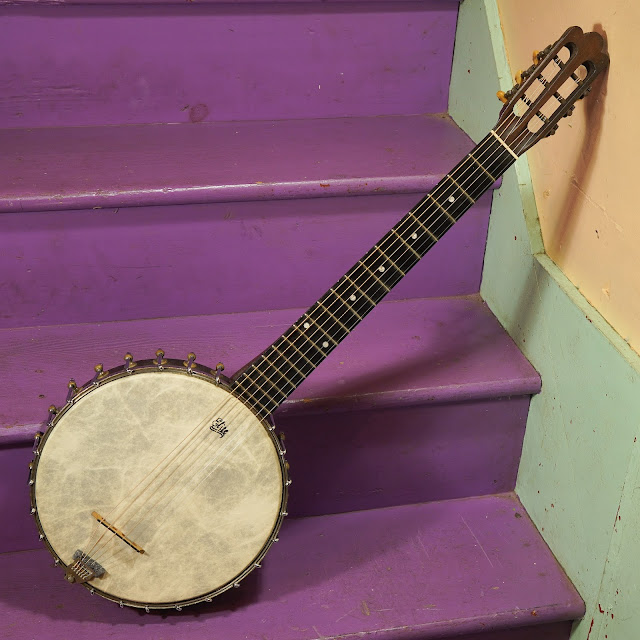1880s Buckbee-made 6-String Banjitar
Update 2022: the owner decided to part with this and aside from a new, better-functioning bridge, it's as per the original blog post. Here's that new bridge:
While there's no stamp of the make on this banjo, to my eyes it's pretty clearly a Buckbee (later, Lange factory) instrument from the late 1880s or early 1890s. The boat-shaped heel with its customary cutout as well as the walnut neck and thin-style ebony fretboard all seem to point to it.
As far as banjos from this time go, though, this thing is downright quirky. I've never played a banjo-guitar ("banjitar") this early before. When it was made I'm assuming it was meant for gut (modern: classical, nylon, or Nylgut) strings and that would have been my inclination setup-wise, but it arrived here via its current owner strung with extra-light steel and the neck was straight and happy so that's what I restrung it with.
My work was glorified setup stuff but it was necessary. In the end, it made an "already-worked-on" instrument properly playable and this thing is simply a joy to pick on now that it's dialed-in. The neck is quick and comfortable (I love me some Buckbee neck) and this has a quieter but very satisfying tone.
The rim construction is odd, too -- it's a normal "thin shell" wood rim like you'd see from the time, but it has wider "rim caps" on either side. The top "cap" is shaped to give a semblance of a tonering but I'm pretty sure the reason for the caps was to increase rim rigidity more than anything else. The neck is bolt-on (yay) and has 3-bolt mounting at the heel.
The most interesting bit of the design is the inclusion of a mini-resonator backplate. This serves to make it more comfortable to hold but it also reflects some of the sound back into the instrument and, if you're A/Bing the sound with/without the backplate, you will immediately notice that the sound is more fundamental and clean with it attached. It works beautifully and looks great, too.
Repairs included: fret seating, fret level/dress, side dots, bridge compensation, cleaning, setup, adjustments.
Rim wood: walnut with veneers
Tonering: none, shaped rim top
Bridge: older ebony/maple
Fretboard: ebony
Neck wood: walnut
Action height at 12th fret: 3/32" bass and 1/16" treble (fast)
String gauges: 46w, 36w, 26w, 18w, 13, 10 custom XL set
Neck shape: slim-medium C/V hybrid
Board radius: flat
Truss rod: n/a
Neck relief: straight
Fret style: medium-lower (replacements)
Scale length: 24 5/16"
Nut width: 1 3/4"
Head diameter: 11”
Depth overall at rim: 3"
Weight: 4 lbs 15 oz
Condition notes: for its age, it's in surprisingly-good shape. The frets are later replacements as are all of the hooks. The shoes are original, though. The tension hoop and tailpiece look like 1920s stuff, but the tailpiece might be original or close to era-correct. The tuners are correct but the nut is a later replacement. The fretboard dot markers are replacements, too.



















Comments